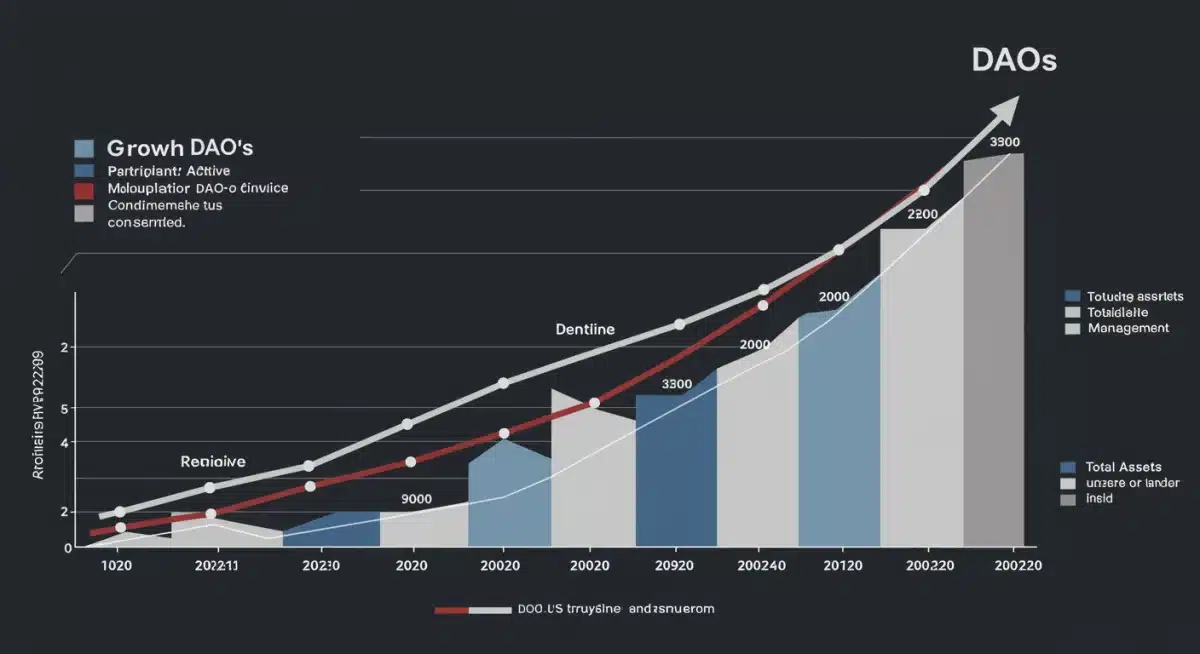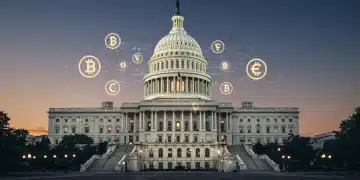DAOs in US Digital Landscape 2025: An Insider Look

The 2025 outlook for Decentralized Autonomous Organizations (DAOs) in the U.S. digital landscape reveals critical shifts in regulation, technology adoption, and governance models. This insider knowledge provides essential insights for navigating the evolving decentralized ecosystem.
The Rise of Decentralized Autonomous Organizations (DAOs) in the U.S. Digital Landscape: A 2025 Outlook (INSIDER KNOWLEDGE) is shaping today’s agenda with new details emerging from officials and industry sources. This update prioritizes what changed, why it matters, and what to watch next, in a clear news format.
The Current State of DAOs in the U.S. Digital Landscape
Decentralized Autonomous Organizations (DAOs) have rapidly evolved from theoretical concepts into tangible entities, fundamentally altering how communities and projects are governed. As of early 2025, the U.S. digital landscape is witnessing an unprecedented surge in DAO formation and participation, driven by advancements in blockchain technology and a growing demand for transparent, community-led governance models. This expansion is not uniform, however, with specific sectors showing more aggressive adoption than others.
The proliferation of DAOs extends beyond mere financial applications, now encompassing areas such as content creation, scientific research, and even local governance initiatives. This diversified application highlights the versatility and inherent appeal of decentralized structures. Early adopters and innovators are consistently pushing the boundaries of what DAOs can achieve, influencing everything from intellectual property management to charitable giving. The underlying ethos of shared ownership and collective decision-making resonates deeply within various digital communities.
Key Growth Sectors
- DeFi (Decentralized Finance) DAOs: Still the largest segment, governing protocols like Aave, Uniswap, and Compound, managing billions in assets and shaping the future of financial services.
- NFT and Metaverse DAOs: Growing rapidly, focused on digital asset ownership, virtual world development, and community curation of digital art and experiences.
- Social DAOs: Emerging as platforms for community building, content sharing, and collective action, often with a focus on specific social or political causes.
- Grants and Investment DAOs: Streamlining funding for projects within the Web3 ecosystem, offering a transparent and democratized approach to capital allocation.
These sectors illustrate the broad impact of DAOs, moving beyond initial expectations to create new forms of digital interaction and economic models. The ability for participants to directly influence decisions and share in collective success is a powerful driver for this growth. Understanding these trends is crucial for anyone looking to navigate the evolving US DAO Landscape 2025.
Regulatory Challenges and Emerging Frameworks for DAOs
The rapid expansion of DAOs has inevitably outpaced traditional regulatory frameworks, creating a complex legal and compliance environment in the United States. As DAOs gain more prominence, federal and state regulators are grappling with how to classify and oversee these decentralized entities without stifling innovation. This regulatory uncertainty is perhaps the most significant hurdle for DAOs seeking mainstream adoption and institutional integration.
Current discussions revolve around whether DAOs should be treated as partnerships, corporations, or entirely new legal structures. Each classification carries distinct implications for liability, taxation, and governance requirements. Several states, including Wyoming and Vermont, have taken proactive steps to establish legal frameworks specifically for DAOs, aiming to provide clarity and attract blockchain-based businesses. These pioneering efforts are closely watched, as they could set precedents for national-level regulation.

State-Level Innovations
- Wyoming DAO LLCs: Offering legal recognition for DAOs as limited liability companies, providing a pathway for legal incorporation and limiting personal liability for members.
- Vermont Blockchain-Based LLCs: Similar initiatives exploring legal recognition for blockchain-based entities, fostering a more favorable environment for decentralized organizations.
- Emerging State Legislation: Other states are actively studying or drafting legislation to address the unique characteristics of DAOs, indicating a growing awareness and willingness to adapt.
Despite these advancements, a unified federal approach remains elusive. Agencies like the SEC and CFTC continue to issue guidance and enforce actions on a case-by-case basis, often relying on existing securities and commodities laws. This piecemeal approach creates a fragmented regulatory landscape, making compliance a significant challenge for DAOs operating across state lines or with a national user base. The ongoing debate underscores the need for clear, comprehensive guidelines to ensure the sustainable growth of the US DAO Landscape 2025.
Technological Advancements Fueling DAO Evolution
The operational efficiency and scalability of DAOs are intrinsically linked to underlying technological advancements, particularly within blockchain and Web3 infrastructure. As we move into 2025, significant strides in these areas are enabling DAOs to become more sophisticated, secure, and user-friendly. These innovations are crucial for overcoming previous limitations and expanding the practical applications of decentralized governance.
Improvements in smart contract platforms, such as Ethereum’s ongoing development and the rise of alternative Layer 1 and Layer 2 solutions, are providing DAOs with faster transaction speeds, lower costs, and enhanced interoperability. These foundational upgrades translate directly into more efficient voting mechanisms, treasury management, and dispute resolution processes. Furthermore, the integration of zero-knowledge proofs and other privacy-enhancing technologies is addressing concerns around data confidentiality, allowing for more complex and sensitive DAO operations.
Core Technological Drivers
- Scalability Solutions: Layer 2 networks (e.g., Optimism, Arbitrum) and sharding implementations reduce gas fees and increase transaction throughput, making DAO operations more accessible and affordable.
- Interoperability Protocols: Cross-chain bridges and communication protocols enable DAOs to interact with assets and applications across different blockchain networks, fostering a more connected ecosystem.
- Advanced Governance Tools: Development of specialized platforms for proposal creation, voting, and treasury management (e.g., Snapshot, Tally) is streamlining DAO operations and enhancing participant engagement.
- Decentralized Identity (DID): Solutions like ENS and other DID platforms are providing secure and verifiable digital identities, critical for reputation-based governance and preventing Sybil attacks within DAOs.
The convergence of these technologies is not merely incremental; it represents a paradigm shift in how DAOs function and interact with their members. As these tools become more robust and accessible, the barrier to entry for both creating and participating in DAOs lowers, paving the way for broader adoption and innovation within the US DAO Landscape 2025. These technological underpinnings are vital for the sustained growth and effectiveness of decentralized governance.
The Economic Impact and Investment Landscape of DAOs
The economic footprint of Decentralized Autonomous Organizations in the U.S. is rapidly expanding, attracting significant capital and fostering new investment paradigms. As of 2025, DAOs collectively manage substantial treasuries, often denominated in native tokens and stablecoins, representing a growing segment of the digital economy. This financial power fuels innovation, supports decentralized projects, and offers unique investment opportunities that diverge from traditional venture capital models.
Investment in DAOs is multifaceted, ranging from direct token purchases that grant governance rights to participation in DAO-managed funds and grant programs. Institutional investors, venture capitalists, and even traditional corporations are increasingly exploring ways to engage with DAOs, recognizing their potential for disruptive innovation and community-driven value creation. The transparency inherent in DAO treasuries and decision-making processes provides a new level of accountability for investors, although it also presents novel risks.

Investment Trends and Opportunities
- Treasury Diversification: DAOs are actively diversifying their treasuries beyond native tokens into more stable assets and even real-world assets (RWAs), enhancing financial stability and utility.
- DAO-to-DAO Collaborations: Strategic partnerships and mergers between DAOs are becoming more common, creating synergistic ecosystems and expanding collective influence.
- Liquid Staking and Yield Farming: DAOs are leveraging DeFi protocols to generate yield on their assets, further increasing their financial resilience and funding capabilities.
- Venture DAO Model: Funds structured as DAOs are democratizing access to early-stage investments, allowing a broader community to participate in and benefit from emerging Web3 projects.
The economic impact of DAOs extends beyond their treasuries, fostering a vibrant ecosystem of developers, auditors, and community managers. This creates new job opportunities and drives economic activity within the digital sphere. The evolving investment landscape around DAOs signifies a maturation of the decentralized economy, positioning DAOs as key players in shaping the financial future of the US DAO Landscape 2025.
Governance Models and Participant Engagement in DAOs
Effective governance is the cornerstone of any successful Decentralized Autonomous Organization, directly impacting its resilience, adaptability, and ability to execute its mission. In the US DAO Landscape 2025, a diverse array of governance models is being experimented with, each designed to optimize decision-making and maximize participant engagement while mitigating potential pitfalls like voter apathy or centralization risks. The continuous evolution of these models reflects the dynamic nature of decentralized communities.
From simple one-token-one-vote systems to more nuanced quadratic voting and delegated proof-of-stake mechanisms, DAOs are constantly refining their approaches. The goal is to strike a balance between broad participation and efficient decision-making. Tools that facilitate off-chain signaling, like Snapshot, allow for cost-effective polling before on-chain votes, reducing friction and encouraging more frequent community input. Reputation-based systems are also gaining traction, aiming to reward active and constructive contributors with greater influence.
Evolving Governance Mechanisms
- Token-Weighted Voting: The most common, where voting power correlates with the amount of governance tokens held, often criticized for potential whale dominance.
- Quadratic Voting: Aims to reduce the influence of large token holders by making additional votes disproportionately more expensive, promoting broader participation.
- Delegated Voting: Allows participants to delegate their voting power to trusted representatives, addressing voter apathy and leveraging expert knowledge.
- Holographic Consensus: Uses prediction markets to incentivize honest voting and discourage malicious proposals, enhancing decision quality.
- Soulbound Tokens (SBTs): Explored as non-transferable tokens representing reputation or credentials, potentially enabling more nuanced and meritocratic governance structures.
Beyond the technical mechanisms, the cultural aspect of DAO governance – fostering active discussion, respectful debate, and transparent communication – is equally critical. Community managers and facilitators play an increasingly vital role in nurturing an engaged and informed member base. As DAOs mature, the effectiveness of their governance models will be a primary determinant of their long-term success and influence within the broader digital economy.
Predictions for the US DAO Landscape in 2025
Looking ahead to the remainder of 2025, several key trends and developments are poised to significantly shape the US DAO Landscape 2025. These predictions are based on current technological trajectories, evolving regulatory discussions, and the increasing mainstream recognition of decentralized governance models. The coming months are expected to be a period of both consolidation and accelerated innovation for DAOs in the United States.
We anticipate a clearer, albeit still evolving, regulatory stance from federal bodies. While a comprehensive federal framework might not fully materialize this year, increased regulatory guidance and perhaps a few landmark court decisions could provide much-needed clarity on legal classifications and compliance obligations. This will likely push DAOs towards more structured legal wrappers, potentially leading to a hybridization of decentralized and traditional legal forms to mitigate risk and attract institutional capital.
Key Predictions
- Increased Regulatory Clarity: Expect more definitive guidance from federal agencies, potentially leading to specific legal classifications for DAOs, reducing current ambiguities.
- Hybrid DAO Structures: A rise in DAOs adopting legal wrappers (e.g., LLCs, foundations) to navigate regulatory requirements while maintaining decentralized operations.
- Enterprise DAO Adoption: Traditional businesses will increasingly experiment with DAO-like structures for internal governance, supply chain management, or specific project funding.
- Enhanced User Experience: Tools and platforms for DAO participation will become more intuitive and user-friendly, lowering the barrier to entry for non-technical users.
- Focus on Real-World Assets (RWAs): DAOs will increasingly explore tokenizing and managing real-world assets, bridging the gap between traditional finance and decentralized ecosystems.
Furthermore, the integration of AI into DAO tooling is expected to enhance efficiency in proposal generation, treasury analysis, and risk management, though careful consideration of centralization risks associated with AI will be paramount. The emphasis will shift towards sustainable economic models, robust security practices, and genuinely decentralized decision-making. The next phase for DAOs in the U.S. will be defined by their ability to scale responsibly, adapt to external pressures, and deliver tangible value to their communities and the broader digital economy.
Key Aspect |
2025 Outlook |
|---|---|
Regulatory Environment |
Increased state-level clarity; federal guidance remains fragmented but evolving. |
Technological Foundation |
Enhanced scalability, interoperability, and user-friendly governance tools. |
Economic Impact |
Significant capital inflow, treasury diversification, and new investment models. |
Governance & Engagement |
Diverse models, focus on active participation, evolution towards meritocratic systems. |
Frequently Asked Questions About DAOs in 2025
The primary challenge remains regulatory uncertainty. While some states offer clear frameworks, a unified federal approach is still developing. This creates complexities regarding legal classification, liability, and taxation, which can hinder mainstream adoption and institutional engagement for DAOs.
Technological advancements in blockchain scalability (Layer 2s), interoperability, and specialized governance tools are crucial. These innovations lead to lower transaction costs, faster decision-making, and more user-friendly participation, making DAOs more efficient and accessible for a broader audience.
State-level regulations, particularly from states like Wyoming and Vermont, are pioneering legal recognition for DAOs. These frameworks offer legal clarity and limited liability, acting as vital incubators for DAO development. They also serve as potential models for future federal or broader state-level legislation.
Yes, traditional institutions, including venture capitalists and corporations, are increasingly exploring investments in DAOs. They are attracted by the transparency of DAO treasuries and the potential for community-driven innovation. This trend signifies a growing acceptance of decentralized financial structures within the broader investment landscape.
Governance evolution in 2025 will focus on balancing broad participation with efficient decision-making. We expect a shift towards more sophisticated models like quadratic voting, delegated systems, and reputation-based mechanisms to combat voter apathy and enhance the quality of collective decisions within DAOs.
Outlook: Navigating the Evolving DAO Ecosystem
The US DAO Landscape 2025 is undeniably in a transformative phase, marked by both immense potential and significant challenges. The ongoing interplay between technological innovation, regulatory adaptation, and community-driven governance will define the trajectory of Decentralized Autonomous Organizations. As these entities continue to mature, their ability to provide transparent, efficient, and equitable solutions will solidify their place in the digital economy. Stakeholders must remain vigilant, adapting to new legal interpretations and embracing evolving best practices to fully harness the power of decentralization. The coming years will be crucial in determining how DAOs integrate into the broader economic and social fabric of the United States.





